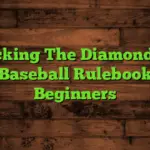Want to improve your baseball skills without leaving home? This comprehensive guide provides everything you need to know about how to practice baseball at home, covering drills, equipment, and essential tips for players of all levels. We’ll explore how to work on hitting, pitching, fielding, and even strength and conditioning, all within the confines of your own backyard or living room. You’ll learn about maximizing space, choosing the right equipment, and creating a personalized training plan to help you reach your full potential. Let’s get started!
Consistent practice is the cornerstone of success in baseball. While team practices and games are crucial, dedicated home practice allows you to focus on individual skills, refine techniques, and build muscle memory at your own pace. This focused training can significantly enhance your overall game. It’s a chance
to address weaknesses, solidify strengths, and develop a deeper understanding of the mechanics involved in each aspect of the sport.
Essential Equipment for Home Baseball Practice
You don’t need a full baseball field to practice effectively. Some key equipment can transform your backyard or even your living room into a productive training space. This includes a quality baseball bat (consider weight and size appropriate for your age and skill level), soft baseballs for indoor use, a pitching machine (for advanced training), a batting tee, and a sturdy net to prevent balls from flying off into unwanted areas. For fielding practice, a soft baseball glove and a few small balls are sufficient. Consider also having cones or markers for setting up drills.
Hitting Practice at Home: Drills and Techniques
Hitting is a fundamental aspect of baseball. At home, you can focus on specific elements like swing mechanics, timing, and contact. A batting tee is invaluable for practicing your swing without needing a pitching partner. Focus on maintaining a consistent stance, smooth swing path, and following through. Drills focusing on specific aspects such as the top hand grip, the bottom hand grip and the overall swing motion are essential.
Dry Swings
Perform dry swings (without a ball) to refine your swing path and body mechanics. Focus on proper weight transfer and rotational power. You can even use a mirror to analyze your form.
Tee Work
Use a batting tee to repeatedly practice your swing, focusing on contact and consistent bat path. Vary the height and position of the tee to simulate different pitches.
Soft Toss
Have a partner or family member softly toss balls to you to practice timing and hand-eye coordination.
Pitching Practice at Home: Mastering Your Delivery
Perfecting your pitching technique takes patience and consistent practice. At home, you can focus on the mechanics of your delivery without the pressure of a game. Begin with warm-up exercises to prevent injury. Focus on your grip, your arm motion, and following through with your body’s rotation.
Arm Strength and Conditioning
Incorporate exercises that focus on arm and shoulder strength, such as light weights, resistance bands, and stretching. Consult resources for suitable exercises to avoid injury.
Accuracy Drills
Aim to throw at a target (a bucket, cone, or spot on the wall) to improve your accuracy and control. Gradually increase the distance as your accuracy improves.
Grip Variation
Practice different pitching grips to develop variety in your pitches. Remember to focus on the fundamentals of each grip to prevent injury.
Fielding Drills for Home Practice
Fielding requires quick reflexes, accurate throws, and a strong arm. At home, you can simulate many fielding scenarios. Use soft baseballs to prevent damage and work on your glove work, footwork, and throwing technique. Simple drills like catching balls off a wall and throwing to a target are effective.
Ground Balls
Roll soft balls gently towards yourself and practice your fielding technique. Focus on getting low to the ground and using your glove hand correctly.
Fly Balls
Toss soft balls into the air and practice catching them. Concentrate on hand-eye coordination, using your glove, and tracking the ball’s trajectory. A partner can help with this.
Throwing Accuracy
Set up targets at varying distances and practice throwing accurately. Focus on your throwing motion and follow-through.
Strength and Conditioning Exercises for Baseball
Baseball requires a combination of strength, agility, and endurance. Incorporate strength training exercises into your home practice routine to enhance your overall performance. Focus on bodyweight exercises that target major muscle groups.
Bodyweight Exercises
Push-ups, sit-ups, squats, lunges, and planks are all effective bodyweight exercises to build strength and improve endurance.
Resistance Training
If you have access to resistance bands or light weights, incorporate these into your workouts to increase muscle strength and power.
Plyometrics
Plyometric exercises, like box jumps and jump squats, enhance explosiveness and agility – crucial for baseball.
Space Optimization for Home Baseball Practice
Even small spaces can be effectively utilized for baseball practice. Use walls to practice catching and throwing, utilize a corner for soft toss drills, and a smaller net for swing practice. Be creative, and adjust your drills accordingly.
Using Limited Space Effectively
A net is essential to contain balls and protect windows. Smaller nets are available to reduce space requirements. Focus on drills emphasizing accuracy rather than power.
Indoor Practice Considerations
For indoor practice, use softer balls and consider the risk of breaking fragile items. Focus on form and drills with limited movement. A sturdy hitting net is a must-have.
Choosing the Right Bat for Home Practice
Select a bat suitable for your skill level and the type of practice. For indoor practice, a lighter weight aluminum bat is generally preferred to prevent damage. Remember safety and prioritize correct size for your age.
Bat Weight and Material
Lighter bats are better for indoor use and for younger players. Aluminum bats are more durable than wooden bats and safer for home practice.
Bat Size Considerations
The correct bat size is crucial for proper swing mechanics. Use recommended sizing charts based on age and height.
Creating a Personalized Home Baseball Training Plan
Tailor your training to your individual needs and goals. A well-structured plan should balance hitting, pitching, fielding, and strength training. Plan out how much time you dedicate to each aspect each week. Aim for consistency rather than intensity to avoid injury.
Weekly Training Schedule
A sample schedule could include 2 days for hitting, 1 day for pitching, 1 day for fielding, and 2 days for strength training. Adjust this based on your individual needs and your available time.
Progress Tracking
Track your progress to monitor improvement and identify areas needing more attention. This can include noting your batting average from your tee work, your pitching accuracy, or your fielding success rate.
Safety Precautions for Home Baseball Practice
Safety should always be a top priority during home practice. Always use soft balls indoors, ensure adequate space to avoid hitting objects or people, and warn those around you during practice. Wear appropriate protective gear. Never swing a bat without proper space and supervision.
Indoor vs. Outdoor Practice
Outdoor practice requires more consideration for surrounding areas. Ensure clear space and a suitable net for your bat swings and your pitches.
Protective Gear Recommendations
Protective eyewear should always be worn during practice. A batting helmet might also be a good idea, depending on the intensity of your practice sessions.
Home Baseball Practice vs. Formal Coaching
Home practice complements but doesn’t replace formal coaching. Coaches provide expert guidance, feedback, and structured training. Home practice provides the opportunity for focused self-improvement and repetition of techniques.
Combining Home Practice with Coaching
Ideally, home practice enhances what you’ve learned from your coach. Practice the drills and techniques they’ve shown you, and use home practice to further hone those skills.
Self-Assessment and Improvement
Use home practice as an opportunity for self-reflection and improvement. Pay attention to areas where you are excelling and where you need additional practice. Be critical but encouraging of your efforts.
Advanced Drills and Techniques for Experienced Players
Experienced players can incorporate more advanced drills to further refine their skills. This might involve using specialized equipment, incorporating video analysis, or focusing on highly specific aspects of their game. Consider advanced drills like reaction drills to improve speed and accuracy.
Video Analysis for Improvement
Record yourself practicing and analyze your technique to identify areas for improvement. Pay attention to posture, swing path, and follow-through for each drill.
Incorporating Game-Like Scenarios
Try to incorporate game-like situations during your home practice. If possible, have a partner to practice hitting and pitching against, or throw against a wall and mimic a fielding scenario.
Troubleshooting Common Home Baseball Practice Challenges
You might face challenges such as limited space, lack of equipment, or difficulty maintaining motivation. Finding creative solutions is key. Remember that consistency is more valuable than intensity.
Overcoming Space Constraints
If space is limited, consider using a smaller net, focusing on drills that require minimal space, and prioritizing form over power.
Maintaining Motivation
Set realistic goals, track your progress, and reward yourself for milestones reached. Practice with a friend or family member to make it more fun and engaging.
Frequently Asked Questions
What are the benefits of practicing baseball at home?
Practicing baseball at home allows you to focus on individual skills, build muscle memory, and improve your overall game at your own pace. It’s a great way to address weaknesses and solidify strengths without the pressure of a game or team practice.
What equipment do I need for home baseball practice?
Essential equipment includes a bat, soft baseballs, a batting tee, a net, and a glove. A pitching machine can be useful for advanced training, but is not strictly necessary. Consider cones or markers for setting drills.
How can I improve my hitting at home?
Focus on swing mechanics, consistent contact, and timing using a batting tee and soft toss drills. Work on your grip and ensure your swing has proper weight transfer and power.
How can I improve my pitching at home?
Practice your delivery, focusing on grip, arm motion, and follow-through. Throw at targets to improve accuracy. Remember to warm up properly and incorporate arm strengthening exercises.
How can I improve my fielding at home?
Practice catching and throwing using soft balls. Work on your glove work, footwork, and throwing accuracy. Simulate game scenarios to improve your reactions.
How do I create a personalized training plan?
Assess your strengths and weaknesses. Create a schedule balancing hitting, pitching, fielding, and strength training. Track your progress and adjust your plan as needed.
What safety precautions should I take during home practice?
Always use soft balls indoors and ensure adequate space to avoid hitting objects or people. Wear protective eyewear and be aware of your surroundings. Never practice with a live ball unless you have the proper protective equipment and adult supervision.
Final Thoughts
Mastering baseball requires consistent dedication and focused practice. This guide highlights the numerous benefits of home practice. Remember to tailor your approach to your skill level and available resources. By incorporating the drills and techniques outlined, you can effectively improve your baseball skills from the comfort of your own home. Remember to always prioritize safety and enjoy the process of honing your craft. With consistent effort and the right approach, you’ll see significant improvements in your game. So, grab your equipment, create your training plan, and start practicing! Remember to prioritize safety and have fun!





